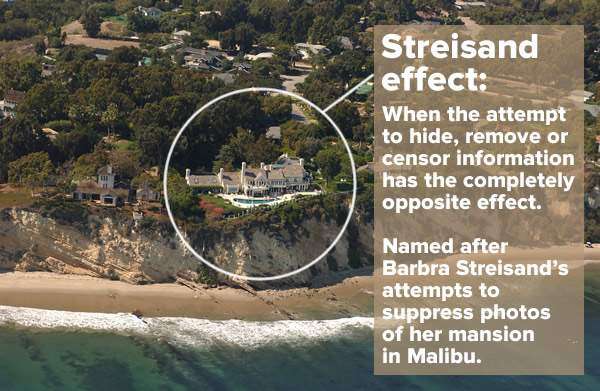
Image Credit globalnerdy
The Streisand Effect is an unintended consequence of attempts to remove, hide, or censor information, where the effort instead backfires by raising awareness of that information. The name derives from American actress and singer Barbra Streisand’s lawsuit against a photographer in 2003, which brought attention to the picture she was suing to have taken off the Internet.
Origin Of The Story
Barbra’s lawsuit was filed against Kenneth Adelman, a photographer who is the founder of the California Coastal Records Project, for which he photographed the coastline of the state from a helicopter and posted the pictures to the Internet. Kenneth specified that the pictures were free for nonprofit use and had been used by government entities for scientific research.
Among more than 12,000 pictures of California’s coast was one picture in which Streisand’s Malibu mansion came. Streisand, who had in the past been stalked and harassed by fans, sued for $50 million, claiming that the picture broke her privacy and revealed how to access her residence.
At the time the lawsuit was filed, the picture had been downloaded only 6 times. This includes twice by the lawyers of Streisand. The lawsuit was highly publicized, and a burst of interest and activity followed. In the month after the filing of the lawsuit, the picture was viewed more than 420,000 times and reposted in the news articles and elsewhere on the Internet. Thus, Streisand’s attempts to have the picture suppressed made it exceptionally more popular than it would otherwise have been. The lawsuit was dismissed and she was ordered to pay Adelman’s $177,000 legal fees for the case. The picture remains widely published on the Internet.
Where did the term come from
The term Streisand effect was stamped by writer Mike Masnick in 2005, who named the effect in an article he wrote for the website Techdirt about a resort that attempted to remove pictures of its urinals from a urinal picture collection website. Masnick named the effect of the phenomenon in the course of comparing the effect of the resort’s picture takedown request to Streisand’s attempt to remove the picture of her house. The term has become increasingly popular. It is with awareness of the term likely rising each time it is applied to a new example of the phenomenon.
Masnick completed his article with a concluding statement. He asks, “How long is it going to take before lawyers realize that the simple act of trying to repress something they don’t like online is likely to make it so that something that most people would never, ever see…is now seen by many more people? Let’s name it the Streisand Effect.”
Equivalent Saying In Chinese
The phenomenon is also known in Chinese culture. It is described by the chengyu idiom yù gài mí zhāng, which translates as “wishing to cover, more conspicuous.”A similar expression appeared as early as the 4th century BC.
Examples Of The Streisand Effect In Action
Since the Streisand lawsuit incident, the Streisand Effect has happened many times. Especially in the digital age where information spreads so fast.
In 2008, a blog post describing weaknesses in the Church of Scientology’s operations resulted in a take-down notice from the Church. Instead of vanishing, the information proliferated across the internet, leading to more spread and criticism of the Church.
In 2009, the UK law firm Carter-Ruck tried to defeat a report about its client Trafigura. It is a commodity trading firm which was involved in a toxic waste scandal. A gag order initially stopped The Guardian from reporting on the issue. A judge raised the order after intense public outcry and online sharing of the information.
In 2012, a U.K. high court gave the order to 5 Internet service providers to restrict access to The Pirate Bay. It is a file-sharing website. The subsequent media coverage of the ruling caused visits to the site to rise by more than 10 million.
The Streisand Effect’s Power
The Streisand Effect shows the immense power of social media and the internet in the spread of data or information. It also illustrates the backlash that can result from attempts to disappear it. The digital age has shifted control over data. It has shifted from those with traditional power (like brands, celebrities, and governments) to the broader public.
This effect raises important considerations for big brands, celebs, companies, and institutions in how they potentially handle their damaging information. Attempting to remove such information can often make matters worse. It can even cause more damage to a reputation than ignoring it or addressing it openly.